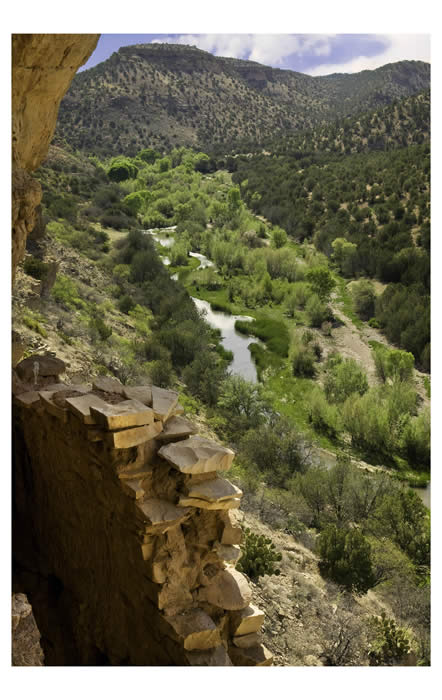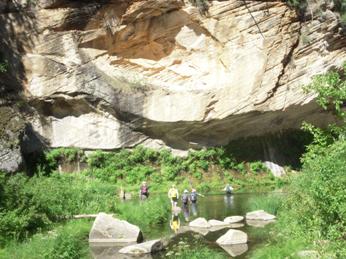Upper Verde Watershed Region
Our Regional Work: Verde River Wild & Scenic
Campaign
Building a Bright Future for Arizona’s Critically Endangered
River
Species Diversity | Geologic
Significance | Recreational Opportunities
 In an arid state, it’s hard to image a scene of lush green banks
and unspoiled riparian habitat, flush with bird species that would bring
birder watchers for miles… The Verde River offers just that. For
kayakers, wildlife enthusiasts, and those who are committed to the health
of our state’s few wild rivers, the Verde offers a hidden paradise.
Still relatively remote and isolated, the Upper Verde River is home to
thousands of plant and animal species, including nesting Bald Eagles. In an arid state, it’s hard to image a scene of lush green banks
and unspoiled riparian habitat, flush with bird species that would bring
birder watchers for miles… The Verde River offers just that. For
kayakers, wildlife enthusiasts, and those who are committed to the health
of our state’s few wild rivers, the Verde offers a hidden paradise.
Still relatively remote and isolated, the Upper Verde River is home to
thousands of plant and animal species, including nesting Bald Eagles.
Arizona Wilderness Coalition’s (AWC) Verde River Wild & Scenic
Campaign is building community support and political momentum for adding
the Upper Verde River to our Nation’s Wild & Scenic River System.
Through this designation, the Verde will continue to flow freely without
threat from impending development and other aggressive diversions.
A River Wild
The Verde, along with the San Pedro River in southeast Arizona, is considered one of the last, free-flowing rivers in our state. Bubbling to the surface from
springs above the Mogollon Rim and flowing into the heart of the Sonoran
Desert, the Verde headwaters meander through the pinyon-juniper grasslands
and pine forests of the Prescott National Forest. Almost every native
fish that resides in the river is already or soon-to-be listed under the
Endangered Species Act, along with a number of endangered terrestrial
and bird species. From a recreational perspective, the river is regionally
famous for its kayak, canoe, and rafting opportunities, not to mention
superior hiking, birding, and swimming holes!
Urgent Action is Needed
Arizona’s population growth, manifested by specific proposals to
pump water out of its upper aquifer, threatens the future of the river.
Cities and towns like Prescott Valley, Camp Verde, and Chino Valley are
rapidly expanding, adding water quality and industrial recreation pressures
to the pumping threat. Already, the amount of water flowing the Verde
is documented as declining.

Wilderness areas and National Conservation Areas must be
legislated by the United States Congress, therefore AWC and partners are
working to facilitate the initiative with members of Arizona’s Congressional
delegation. Concurrently, we are engaged in myriad outreach activities
with stakeholders and the public, hosting presentations, field tours,
listening sessions, and negotiation talks. With a solid grassroots support
base, the proposal will have the necessary clout to gain the support of
congress and alleviate opposition.
Our Plan
First, our goal is to facilitate Congressional designation of 50 miles
of the Verde River and two tributaries as Wild & Scenic. This designation
will provide a federal reserved instream water right while setting strong
direction to protect the upper Verde’s unique cultural and environmental
values. Second, we look to integrate the Wild and Scenic designations
with Wilderness designations for federal lands adjacent to the river.
Third, we’re committed to on-the-ground restoration of the river
and its banks through our robust volunteer field program.
We firmly believe that federal legislative protection for the river is
the best strategy to ensure that this increasingly rare, desert riparian
ecosystem remains intact. Our job is to secure a federal “Wild and
Scenic” designation for the Verde over the next two years. AWC is
integrated within the communities of the Verde watershed through our partnerships
with river stakeholders and organizations. For the past ten years, we’ve
centered our Verde River work out of Prescott, where our staff operates
under a joint venture with Prescott College.
Getting the Job Done
A solid foundation for this campaign has been laid in recent years, resulting
from hundreds of presentations about the value of the river, dozens of
public service projects along its main stem and tributaries, and the facilitation
of a stakeholder committee working together to formulate and now execute
the campaign strategy. Momentum already exists. Last year, AWC led the
public support efforts that resulted in a major tributary of the Verde,
Fossil Creek, being designated as a Wild and Scenic River (Senator McCain
was the main sponsor). Fossil Creek was the first Wild and Scenic designation
in Arizona since 1984!
[back to top]
Species
Diversity
 The spectacular Central Arizona region provides
an abundance of vegetative life zones, considering it has an elevation
gradient of more than 7,000 feet from the floor of the desert to the top
of Mount Union in the Bradshaw Mountains. Slope aspect in combination
with elevation dictates the types of vegetation that can be found at any
given place in the Central Mountains ecoregions.
Common plant species range from creosote to ponderosa pine. The spectacular Central Arizona region provides
an abundance of vegetative life zones, considering it has an elevation
gradient of more than 7,000 feet from the floor of the desert to the top
of Mount Union in the Bradshaw Mountains. Slope aspect in combination
with elevation dictates the types of vegetation that can be found at any
given place in the Central Mountains ecoregions.
Common plant species range from creosote to ponderosa pine.
Geologic Significance
The visible geologic record of the Central Mountains/Verde Watershed region spans
approximately 1.7 billion years, when the Central Mountains were created
as part of the Yavapai volcanic arc that welded onto the continent at
this time. These mountains are mostly made up of granitic rocks with relatively
young basalt and lava flows on the surface.
Sedimentary layers found in the bottom of the Grand Canyon are the same
as those found on the surface throughout the Verde Valley and the Mogollon
Rim country below the Colorado plateau. As one descends south into the
Sonoran Desert, the basin and range country unfolds into a unique topography of
mountains and valleys that characterizes the deserts of the southwest.
[back to top]
Recreational Opportunities

The Central Arizona/Verde Watershed region offers an abundance of recreational opportunities
for all seasons. The elevational gradient of over 8,000 feet between the
high country of the Central Mountains to the Phoenix Valley allows for
a variety of outdoor choices. In the summer, the high country and canyons of the Mogollon
Rim and the surrounding Central Mountains provides escape from the searing heat of
the valley with numerous activities from swimming in cold mountain streams
to lounging in the shade of a giant Douglas fir.
The Central Mountains/Verde Watershed region staff and volunteers love to suggest
places to visit for backpacking, fishing, hiking, bird watching, rock
climbing, and even places to enjoy a campfire with some friends. Please
feel free to drop us a line at our office in Prescott.
Be sure to try out one of our Wilderness Stewardship trips!
Photos: Top, American Rivers' conservation director David Moryc joins AWC Central AZ Director Sam Frank in surveying the Upper Verde River and its potential as a Wild & Scenic River segment. Courtesy Doug Von Gausig. Middle left, Ancient native people and their cultures thrived along the Verde River. Courtesy Gary Beverly. Middle right, An osprey soars over the Verde River, courtesy Gary Beverly. Bottom, AWC Wilderness Stewards enjoy a dip in the cool waters of West Clear Creek Wilderness, which is fed by the waters of the Verde Watershed. © AWC
|

